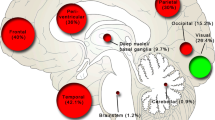Abstract
Objective There has been an increased focus on the region adjacent to the lateral ventricles (LV) as a potential source of malignant tumors and/or more aggressive disease. We set out to determine if glioblastoma multiforme (GBM) bordering the LV was associated with decreased survival as compared to non-LV GBM. Methods We reviewed the clinical records of 69 consecutive patients undergoing craniotomy for GBM at a single academic institution. Twenty-six patients were identified with contrast-enhancing lesions (CEL) bordering the LV (LV CEL). These 26 patients were matched with 26 patients with CEL not bordering the LV (non-LV CEL). These cohorts were matched for factors consistently shown to be associated with survival, which were age, tumor size, Karnofsky performance score, extent of resection, Gliadel implantation, and Temodar chemotherapy. Overall survival was compared between the cohorts via Log-rank analysis. Results Despite similarities in pre-operative clinical status, tumor size, peri-operative outcome, and treatment regimens, the median survival for patients with LV CEL was significantly decreased as compared to patients with non-LV CEL (8 months vs. 11 months), P = 0.02. Additionally, survival analysis in patients stratified by primary and secondary resection also demonstrated a strong trend towards decreased survival after resection of LV CEL. After primary and secondary resection, patients with LV CEL versus non-LV CEL had a median survival of 11 months vs. 14 months (P = 0.10) and 7 months vs. 10 months (P = 0.11), respectively. Conclusion While the causal factors underlying this observation are not provided with this observational study, GBM bordering the LV may carry a prognostic significance.



Similar content being viewed by others
References
DeAngelis LM (2001) Brain tumors. N Engl J Med 344(2):114–123
Stupp R, Mason WP, van den Bent MJ et al (2005) Radiotherapy plus concomitant and adjuvant temozolomide for glioblastoma. N Engl J Med 352(10):987–996
Tait MJ, Petrik V, Loosemore A et al (2007) Survival of patients with glioblastoma multiforme has not improved between 1993 and 2004: analysis of 625 cases. Br J Neurosurg 21(5):496–500
Brem H, Piantadosi S, Burger PC et al (1995) Placebo-controlled trial of safety and efficacy of intraoperative controlled delivery by biodegradable polymers of chemotherapy for recurrent gliomas. The Polymer-brain Tumor Treatment Group. Lancet 345(8956):1008–1012
Chang SM, Parney IF, McDermott M et al (2003) Perioperative complications and neurological outcomes of first and second craniotomies among patients enrolled in the Glioma Outcome Project. J Neurosurg 98(6):1175–1181
Laws ER, Parney IF, Huang W et al (2003) Survival following surgery and prognostic factors for recently diagnosed malignant glioma: data from the Glioma Outcomes Project. J Neurosurg 99(3):467–473
Lamborn KR, Chang SM, Prados MD (2004) Prognostic factors for survival of patients with glioblastoma: recursive partitioning analysis. Neuro Oncol 6(3):227–235
Lim DA, Cha S, Mayo MC et al (2007) Relationship of glioblastoma multiforme to neural stem cell regions predicts invasive and multifocal tumor phenotype. Neuro Oncol 9(4):424–429
Parsa AT, Wachhorst S, Lamborn KR et al (2005) Prognostic significance of intracranial dissemination of glioblastoma multiforme in adults. J Neurosurg 102(4):622–628
Sanai N, Tramontin AD, Quinones-Hinojosa A et al (2004) Unique astrocyte ribbon in adult human brain contains neural stem cells but lacks chain migration. Nature 427(6976):740–744
Holland EC, Celestino J, Dai C et al (2000) Combined activation of Ras and Akt in neural progenitors induces glioblastoma formation in mice. Nat Genet 25(1):55–57
Savarese TM, Jang T, Low HP et al (2005) Isolation of immortalized, INK4a/ARF-deficient cells from the subventricular zone after in utero N-ethyl-N-nitrosourea exposure. J Neurosurg 102(1):98–108
Zhu Y, Guignard F, Zhao D et al (2005) Early inactivation of p53 tumor suppressor gene cooperating with NF1 loss induces malignant astrocytoma. Cancer Cell 8(2):119–130
Altman DG (1991) Practical statistics for medical research. Chapman & Hall/CRC, New York
Carson KA, Grossman SA, Fisher JD et al (2007) Prognostic factors for survival in adult patients with recurrent glioma enrolled onto the new approaches to brain tumor therapy CNS consortium phase I and II clinical trials. J Clin Oncol 25(18):2601–2606
Jalali R, Basu A, Gupta T et al (2007) Encouraging experience of concomitant Temozolomide with radiotherapy followed by adjuvant Temozolomide in newly diagnosed glioblastoma multiforme: single institution experience. Br J Neurosurg 21(6):583–587
Alvarez-Buylla A, Lim DA (2004) For the long run: maintaining germinal niches in the adult brain. Neuron 41(5):683–686
Ljubimova JY, Fujita M, Khazenzon NM et al (2006) Changes in laminin isoforms associated with brain tumor invasion and angiogenesis. Front Biosci 11:81–88
Calabrese C, Poppleton H, Kocak M et al (2007) A perivascular niche for brain tumor stem cells. Cancer Cell 11(1):69–82
Sanai N, Alvarez-Buylla A, Berger MS (2005) Neural stem cells and the origin of gliomas. N Engl J Med 353(8):811–822
Quinones-Hinojosa A, Chaichana K (2007) The human subventricular zone: a source of new cells and a potential source of brain tumors. Exp Neurol 205(2):313–324
Author information
Authors and Affiliations
Corresponding author
Rights and permissions
About this article
Cite this article
Chaichana, K.L., McGirt, M.J., Frazier, J. et al. Relationship of glioblastoma multiforme to the lateral ventricles predicts survival following tumor resection. J Neurooncol 89, 219–224 (2008). https://doi.org/10.1007/s11060-008-9609-2
Received:
Accepted:
Published:
Issue Date:
DOI: https://doi.org/10.1007/s11060-008-9609-2




